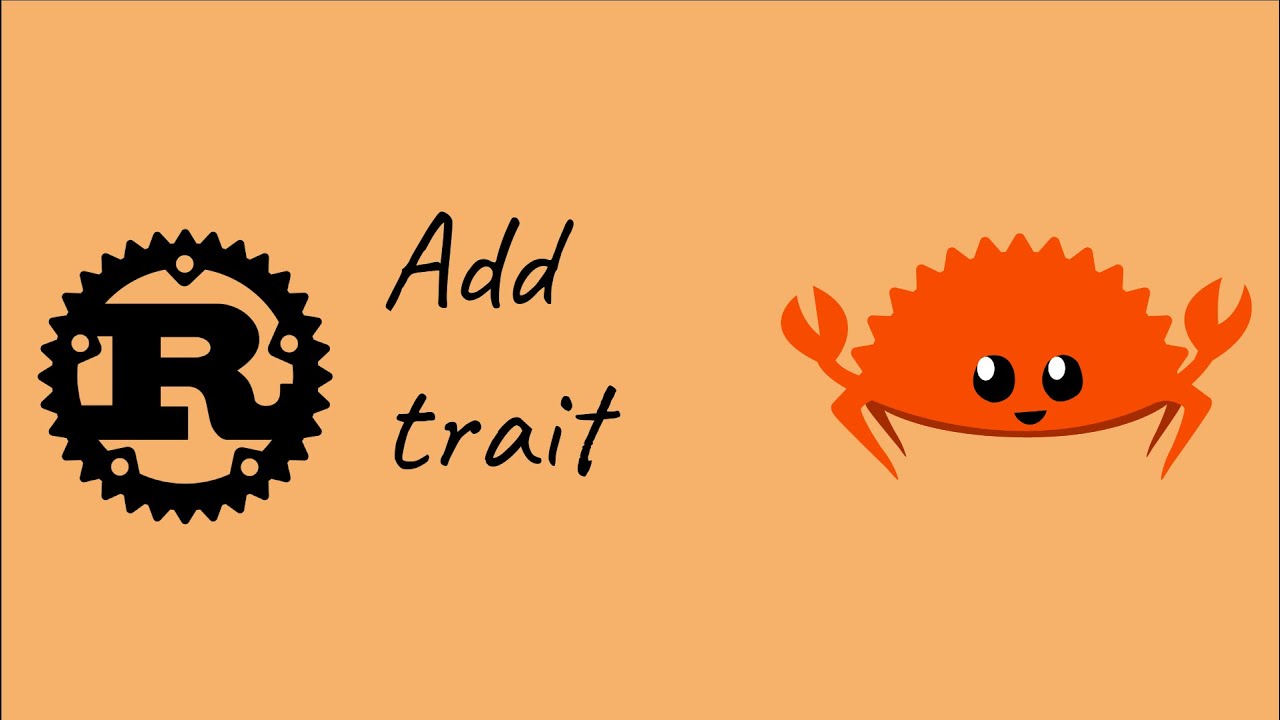Rust trait 入门

学 Rust 的一定离不开 trait, 告诉编译器某些类型拥有的,且能够被其他类型共享的功能,官方的定义叫做 Defining Shared Behavior 共享行为,同时还可以对泛型参数进行约束,将其指定为某些特定行为的类型。读过 你真的了解泛型嘛 朋友肯定知道,rust 的 trait 和 go interface 非常像,但是远比后者强大
Rust Ownership 三原则 开篇讲到对像在离开作用域时,会调用 drop 方法析构,这就是一个 drop trait
trait 简介
定义
Summary 官方示例特征
1 | pub trait Summary { |
pub 关键字表示能被其它模块调用,如果是私有的可以省略。Summary trait 拥有一个函数 summarize, 只需要描述函数签名即可,不需要写上函数体
1 | type Endpoint interface { |
可以看到和 go interface 的定义很像,只不过 go 的 self 是隐式传递的,而 rust 需要显示传递,并且只能是 &self 引用。为什么一定要用引用呢?这是就锈儿们吐糟和难以理解的点:如果传入 self 那么函数就会拥有变量所有权,离开函数后就会被析构 drop 掉
实现
官网以 NewsArticle 和 Twitter 为例子,展示如何实现 Summary trait
1 | pub struct NewsArticle { |
impl 关键字,后面是要实现的 trait 名称,for 后面是结构体名
1 | fn main() { |
调用的话也比较简单,初始化 tweet 对像后,调用相应的方法 summarize 即可。这里可以看到和 go interface 有些区别,go 不需要显示的指定实现了某些接口,而 rust 要显示声明
做为入参
1 | type HandlerFunc func(ResponseWriter, *Request) |
上面是 go net/http 的 ServeHTTP 函数,入参 ResponseWriter 就是一个接口。其实 rust 也常这么用
1 | pub fn notify(item: &impl Summary) { |
这里传入参数 item 类型是 impl Summary 的引用,如果不传引用,所有权又被转移到 notify 函数里
做为出参
1 | fn returns_summarizable() -> impl Summary { |
同样,返回值时,指定类型是 impl Summary, 与 go 不一样的是,函数体内不允许返回不同类型,仅管他们都实现了 Summary
1 | fn returns_summarizable(switch: bool) -> impl Summary { |
比如这种 if-else 编译会报错
1 | | |_|_________^ expected struct `NewsArticle`, found struct `Tweet` |
rust 编译器很智能,提示我们要用 Box<dyn Summary>, 那么最终的实现如下
1 | fn returns_summarizable(switch: bool) -> Box<dyn Summary> { |
trait 与泛型
1 | fn largest<T: PartialOrd + Copy>(list: &[T]) -> T { |
官网给了例子 largest 泛型函数,传入类型 T, 约束是类型必须实现 PartialOrd 与 Copy 特征,用于比较运算和 copy 实现
1 | fn largest<T>(list: &[T]) -> T |
为了简洁,可以使用 where 关键词。 那么问题来了什么时候使用泛型,什么时候使用 trait 呢?
1 | fn largest<T>(left: T, right: T) -> T |
这是泛型函数,由于单态化,传参 left, right 类型都是 T 然后返回 T 类型,要求类型必须一样。不可能传入 i32 返回 i8. 除非泛型签名是 (left: T, right: U)
1 | pub trait Draw { |
例子模拟了 GUI 的屏幕实现,只要实现了 Draw 特征的组件就可以,可以渲染方形,渲染圆形,也可以是三角形
高级特性
默认实现方法
1 | pub trait Summary { |
与 go 不同,rust trait 可以拥有默认实现,这样结构体 impl 时无需实现该方法
1 | pub trait Summary { |
同时,Summary 的默认实现方法,也可以调用其它 trait 方法。如上例所示,Tweet 只需实现 summarize_author 即可
有条件的实现方法
参考 Using Trait Bounds to Conditionally Implement Methods 章节
1 | struct Pair<T> { |
泛型结构体 Pair 拥有两个字段,x, y 类型都是 T. 我们可以针对部份类型实现某些方法,这在 rust 里大量应用 (rust 让人难懂的就是柔和了泛型,生命周期与所有权)
1 | impl<T: Display + PartialOrd> Pair<T> { |
此时只有实现了 Display 和 PartialOrd 的类型,才能调用 cmd_display 方法
blanket implementations
我们同样可以为实现了某个 trait 的类型有条件的实现另外一个 trait, rust 标准库里也大量应用这个方法。对于满足 trait 约束的所有类型实现 trait 也被称作 blanket implementations, 有的翻译成覆盖实现,有的叫一篮子实现
1 | impl<T: Display> ToString for T { |
比如标准库里,给所有实现了 Display 的类型,都实现了 ToString trait
1 | let s = 3.to_string(); |
然后就可以直接用 to_string 将整型转成字符串
继承
trait 同样是可以继承的
1 | trait Vehicle { |
trait Car 实现依赖于 Vehicle, 也就是说,任何想实现 Car 的必须也同时要实现 Vehicle. 可以参考 Fn, FnOnce, FnMut 傻傻分不清
Marker trait
Rust 里有大量的 Marker trait, 不包含任何方法,被称为标记特征,用于告诉编译器这些类型实现了某些特征,得到编译期的某些保证。比如 Sync, Send, Copy 特征
- Send 表示数据能安全地被 move 到另一个线程
- Sync 表示数据能在多个线程中被同时安全地访问
还有需要用到的 Sized, ?Sized 等等
泛型 trait
1 | pub trait From<T> { |
该例子来自 From<T> 与 Into<T> 特征,允许从某种类型,转换为类型 T,反之同样
Associated Types
参考官网 Associated Types, 上面提到了泛型特征,但是实际应用中不够方便,关联类型是更好的选择
trait 实现者需要根据自己特定场景来为联联类型指定具体的类型,通过这一技术,我们可以定义出包含某些类型的 trait, 需无须在实现前确定它们的具体类型。来看一个例子
1 | pub trait Iterator { |
Item 是占位符,next 函数表明它返回类型是 Option<Self::Item>, 实现者只需要为 Item 指定具体的类型
1 | struct Counter { |
看起来并没有什么特殊之处,如果我们用上面提到的泛型 trait 定义会什么样呢?
1 | pub trait Iterator<T> { |
这是一个泛型 trait, 我需要为 Counter 指定 u32 的实现。对于其它的迭代器,需要指定 String 实现,等等。每次使用时,也要标注类型,非常麻烦,如果用关联类型,只需要指定一次
1 | pub trait Add<Rhs = Self> { |
这是运符符重载的例子,网上引用的比较多,大家可以仔细看下实现
小结
本文先分享这些,写文章不容易,如果对大家有所帮助和启发,请大家帮忙点击在看,点赞,分享 三连
关于 trait 大家有什么看法,欢迎留言一起讨论,如果理解有误,请大家指正 ^_^
